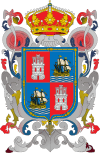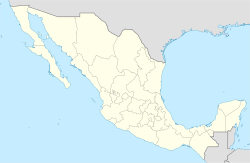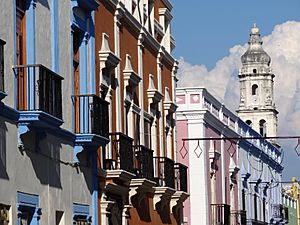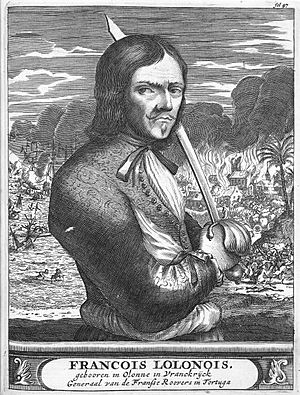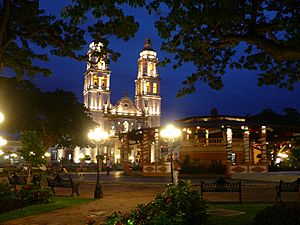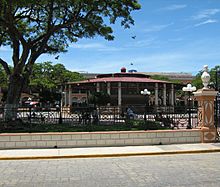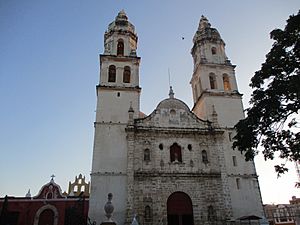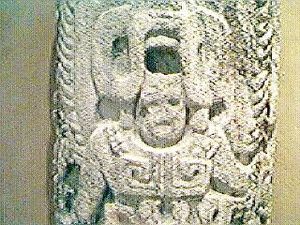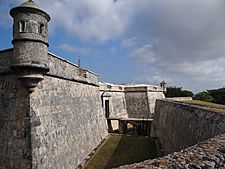Campeche (city) facts for kids
Quick facts for kids
San Francisco de Campeche
Campeche
|
||
|---|---|---|
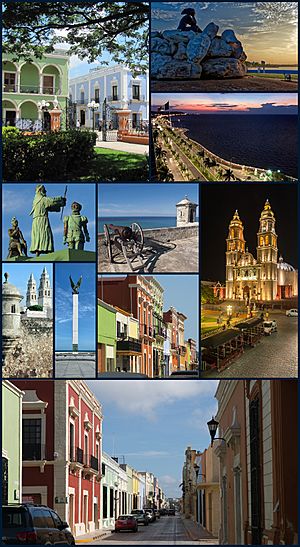
Clockwise from top: Historic Center of San Francisco de Campeche; Monumento la novia del mar; Malecón of the city of Campeche; Monument to Hispanidad; Fort of San Miguel; Parish of Our Lady of the Immaculate Conception Holy Cathedral Church; Colonial architecture; The Mayan Angel; View of the cathedral of campeche from the fortress; Historic Center of San Francisco de Campeche
|
||
|
||
| Country | Mexico | |
| State | Campeche | |
| Municipality | Campeche | |
| City Founded | October 4, 1540 (485 years ago) | |
| Area | ||
| • Total | 52.48 km2 (20.26 sq mi) | |
| Elevation | 10 m (33 ft) | |
| Population
(2020 census)
|
||
| • Total | 249,623 | |
| • Density | 4,756.5/km2 (12,319.4/sq mi) | |
| Demonym(s) | Campechano | |
| Time zone | UTC−6 (Central (US Central)) | |
| • Summer (DST) | UTC−5 (Central) | |
| Area code(s) | 981 | |
| Major Airport | Ing. Alberto Acuña Ongay International Airport | |
| IATA Code | CPE | |
| ICAO Code | MMCP | |
| Website | Official Campeche Website: http://municipiodecampeche.gob.mx/ | |
| Official name: Historic Fortified Town of Campeche | ||
| Type: | Cultural | |
| Criteria: | ii, iv | |
| Designated: | 1999 (23rd session) | |
| Reference #: | 895 | |
| Region: | Latin America and the Caribbean | |
San Francisco de Campeche (also called Campeche) is a city in the Mexican state of Campeche. It is located on the coast of the Bay of Campeche in the Gulf of Mexico. Campeche is the capital city of the state and also the main city of its municipality. In 2010, about 220,389 people lived in the city.
The city was founded in 1540 by Spanish explorers called conquistadores. They built it on top of an older Maya city named Can Pech. Not much is left of the old Maya city today.
Campeche is famous for its old Spanish colonial city walls and forts. These were built to protect the city from pirates and buccaneers. Because of how well-preserved its buildings and walls are, Campeche became a World Heritage Site in 1999. It is one of the few cities in North America with most of its old city walls still standing.
Contents
History of Campeche City
The city of San Francisco de Campeche was founded in 1540. It was built where the Maya city of Can Pech once stood. For many years, pirates attacked Campeche. To stop these attacks, the city started building strong walls and forts in 1686. These defenses were finished in 1704.
First European Visit
The first Spanish group to reach Campeche was the Hernández de Córdoba expedition in 1517. They were among the first Europeans to explore the Yucatán Peninsula. On March 22, they landed at a Maya village called Can Pech. They named it "Saint Lazarus" because it was that saint's day.
The Spanish needed water, so they got it from a well. The Maya chief greeted them peacefully at first. But soon, many Maya warriors arrived. Remembering a past fight, the Spanish decided to leave. They faced rough seas and lost their water, which made them land at another place where a big battle happened.
Spanish Conquest of Campeche
After the Spanish took control of the Aztec Empire, Francisco de Montejo got permission from the king to conquer the Yucatán Peninsula. This conquest happened in three main parts.
First, from 1527 to 1529, Montejo explored the eastern coast. But the Maya people fought back, and the Spanish had to retreat.
Next, from 1530 to 1535, Montejo tried from the west. He founded "Salamanca de Campeche" in 1531. However, his son was defeated in a battle at Chichen Itza. This made the Spanish leave the peninsula for five years.
Finally, from 1540 to 1547, the Spanish returned. Montejo's son and nephew helped to end the Maya rebellions. By 1546, the conquest seemed complete.
Life Under Spanish Rule
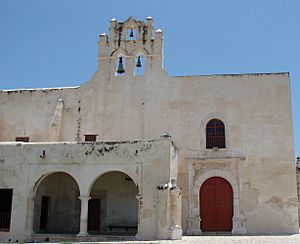
Like most Spanish cities, Campeche was planned in a grid shape. It had a main square called the Plaza de Armas in the center. Important buildings like the Campeche Cathedral and government offices were around this square.
The Spanish people lived near the main square. The local Maya people lived in the surrounding areas, which are now neighborhoods like San Francisco and San Román. People brought from Africa lived in other neighborhoods.
Campeche became a key base for conquering the rest of Yucatán. In 1542, the Spanish founded Mérida, which became the capital of the region.
After the conquest, the Spanish also tried to spread their culture and the Catholic religion. The first religious group to arrive was the Franciscans in 1535. They built a temple and convent dedicated to San Francisco in 1540. They worked to teach the Maya people about Catholicism.
In 1542, the king made new laws to protect the freedom of the native people. While slavery was officially ended, some unfair practices continued. Religious leaders often fought to defend the rights of the indigenous people.
Trade and Pirates
Campeche was an important port in the Gulf of Mexico. It connected the region to other countries, which helped its economy grow. The city traded products like "dye stick" (a type of wood) and salt. Campeche was also known for building ships.
Spain had strict rules about trade, only allowing its colonies to trade with Spain. This led to a lot of illegal trading and piracy. Many famous pirates attacked Campeche, including John Hawkins, Francis Drake, and Henry Morgan.
One very feared pirate was Laurens de Graaf, also known as Lorencillo. In 1685, he attacked and took over Campeche and many nearby towns. He stayed for two months, capturing many people and stealing lots of treasure. He managed to escape Spanish ships by throwing his stolen goods into the sea to make his ship faster.
Another pirate, Jean David Nau, known as El Olonés, also had adventures in Campeche. After losing his ship in a storm, he pretended to be dead to escape the Spanish. He then disguised himself and convinced some enslaved people to help him steal a canoe and escape by sea.
Becoming a City
In 1777, the king of Spain, Carlos III, officially made San Francisco de Campeche a city. Before this, it was just a "villa" (a large town). The city also received its official coat of arms (a special symbol or emblem) that year.
Climate in Campeche
Campeche has a tropical savanna climate. This means it has a wet season from June to October when most of the rain falls. The weather is generally warm all year round.
| Climate data for Campeche (1951–2010) | |||||||||||||
|---|---|---|---|---|---|---|---|---|---|---|---|---|---|
| Month | Jan | Feb | Mar | Apr | May | Jun | Jul | Aug | Sep | Oct | Nov | Dec | Year |
| Record high °C (°F) | 38.8 (101.8) |
39.0 (102.2) |
42.7 (108.9) |
44.0 (111.2) |
45.1 (113.2) |
43.0 (109.4) |
40.0 (104.0) |
40.0 (104.0) |
39.0 (102.2) |
40.5 (104.9) |
38.0 (100.4) |
40.0 (104.0) |
45.1 (113.2) |
| Mean daily maximum °C (°F) | 29.1 (84.4) |
30.6 (87.1) |
32.7 (90.9) |
35.0 (95.0) |
35.9 (96.6) |
34.9 (94.8) |
34.5 (94.1) |
34.2 (93.6) |
33.4 (92.1) |
32.1 (89.8) |
30.7 (87.3) |
29.4 (84.9) |
32.7 (90.9) |
| Daily mean °C (°F) | 23.7 (74.7) |
24.7 (76.5) |
26.5 (79.7) |
28.5 (83.3) |
29.6 (85.3) |
29.2 (84.6) |
28.7 (83.7) |
28.5 (83.3) |
28.2 (82.8) |
27.0 (80.6) |
25.4 (77.7) |
24.0 (75.2) |
27.0 (80.6) |
| Mean daily minimum °C (°F) | 18.2 (64.8) |
18.7 (65.7) |
20.2 (68.4) |
22.1 (71.8) |
23.4 (74.1) |
23.5 (74.3) |
22.9 (73.2) |
22.7 (72.9) |
22.9 (73.2) |
21.9 (71.4) |
20.0 (68.0) |
18.6 (65.5) |
21.3 (70.3) |
| Record low °C (°F) | 8.0 (46.4) |
9.0 (48.2) |
10.0 (50.0) |
13.0 (55.4) |
16.0 (60.8) |
17.0 (62.6) |
18.0 (64.4) |
19.0 (66.2) |
18.0 (64.4) |
15.0 (59.0) |
12.0 (53.6) |
9.0 (48.2) |
8.0 (46.4) |
| Average precipitation mm (inches) | 25.8 (1.02) |
15.8 (0.62) |
12.4 (0.49) |
13.0 (0.51) |
53.9 (2.12) |
162.0 (6.38) |
181.3 (7.14) |
188.2 (7.41) |
203.1 (8.00) |
117.9 (4.64) |
41.0 (1.61) |
25.0 (0.98) |
1,039.4 (40.92) |
| Average precipitation days (≥ 0.1 mm) | 3.9 | 2.5 | 2.0 | 1.3 | 3.9 | 11.7 | 14.8 | 14.6 | 14.3 | 9.3 | 4.7 | 3.5 | 86.5 |
| Average relative humidity (%) | 74 | 71 | 68 | 66 | 64 | 68 | 74 | 76 | 78 | 77 | 77 | 75 | 72 |
| Mean monthly sunshine hours | 216 | 200 | 264 | 267 | 254 | 237 | 241 | 236 | 202 | 208 | 194 | 177 | 2,696 |
| Source 1: Servicio Meteorológico National (humidity 1981–2000) | |||||||||||||
| Source 2: Deutscher Wetterdienst (sun, 1961–1990) | |||||||||||||
People of Campeche
In 2010, the Campeche municipality had a total population of 259,005 people. The city of San Francisco de Campeche is the largest settlement within the municipality.
Some of the other larger towns in the area include Lerma (with 8,281 people) and Chiná (with 5,194 people). There are also many smaller rural communities.
Campeche's Economy
The economy of San Francisco de Campeche mainly relies on services. This includes things like shops, tourism, communication, and government jobs. There are also some factories that make textiles (cloth goods). Smaller businesses often work with products from farming or fishing. Fishing is still an important activity in the area.
Tourism in Campeche
Tourism has grown a lot in Campeche recently. Many visitors come to see the city's special places.
Historic Downtown and Neighborhoods
The historic center of Campeche is a great example of a fortified city from the Spanish colonial period. Its buildings show the Spanish Colonial architecture style. The city's defense system is an important example of how the Spanish built military structures in the 1600s and 1700s. Because of these unique features, UNESCO named it a Cultural Heritage of Humanity site.
Walking through its streets, you can admire the colorful houses. Many have designs from the 18th and 19th centuries. Each street feels full of history and old stories.
The walls around parts of the city remind us of the time when Spain ruled. The churches and forts show how faith and military defense were combined. These buildings protected the people during pirate attacks.
Ancient Maya Sites
Near Campeche, you can visit the ancient Maya sites of Acanmul, Edzná, and Jaina. Campeche is a good starting point to explore other important archaeological sites in the state.
Edzná: The House of the Itzáes
Edzná, meaning "House of the Itzáes," has about twenty large buildings. These show how political, economic, and religious power was centered here long ago.
The valley where Edzná is located often floods during the rainy season. To solve this, the Maya created an amazing water system. They built canals to drain the valley and direct water to a lagoon. This lagoon was turned into a dam to store water. Other canals were used to water crops. This system helped them grow food and also provided fish. The canals even served as travel routes and defenses.
The main plaza at Edzná had a great drainage system. Rainwater flowed into special underground reservoirs called chultunes. The most important building at Edzná is the five-story building, which stands on a large platform.
Jaina: The House on the Sea
Jaina, or "House on the sea," is famous as a Maya necropolis (a large ancient cemetery). Over a thousand human burials have been found here. Many beautiful clay figures were placed in these graves as offerings. When these figures were discovered, they showed how amazing Maya art was.
The Petenes: Unique Ecosystems
Part of Campeche's urban area is next to the Los Petenes Biosphere Reserve. "Petenes" are unique circular areas of vegetation. They form where fresh water springs up in the middle of salty water. This allows plants that don't like salt to grow, creating small islands of diverse plant life.
These areas are important homes and nesting places for many birds and mammals. The coastal mangroves in the reserve have many natural paths. These are great for fishing and watching birds and other animals. The rich natural beauty of the area makes it perfect for ecotourism.
Transportation in Campeche
The city has its own airport, Campeche International Airport, which offers commercial flights.
Culture of Campeche
Traditional Clothing
The typical dress of Campeche has three parts. The top part is like a huipil, but it's embroidered in black with designs of onion and pumpkin flowers. A special shawl called a Santa Maria completes the top. The skirt is long, reaching the ankles, and is made of fine printed fabric.
Music and Dances
People in Campeche love music and dance. Here are some traditional dances:
- Los pregones: These dances show typical Campeche characters selling their goods in the streets.
- Las chancletitas: This dance features quick, agile footwork.
- The shaking: This is an older dance with a fast, lively rhythm, showing Maya influences.
- The cutz: This dance tells the story of a turkey with beautiful feathers. Dancers wear colorful ribbons to represent the feathers.
- Jarana 6x8: A cheerful dance with a special "Guapacheo" style.
- El Gallo: This is an indigenous dance from Lerma, performed on May 3. It's meant to bring good luck for farming. One man dances with a rooster hanging on his back. Women hold gourds with corn seeds that make sounds as they dance.
- Son del turkey: A short, energetic dance from the mid-1800s. Dancers move in pairs, holding arms.
- La Guaranducha: This dance combines the Jarana with a Havana rhythm, showing African influences. Dancers clap and move freely.
- Creole syrup: This old dance was inspired by the sounds of church bells in Campeche.
- Pichito amoroso: A very cheerful and lively dance. Dancers imitate the flight of a bird with their arm movements.
- La Jerengoza: A lively dance where dancers form circles and move quickly, turning towards the center and out.
- The cockroach: This dance is known for its playful and graceful movements. The man places his hands on the woman's shoulders, imitating a cockroach shell.
- Campechito retrechero: A fast dance where dancers show their skill. They might balance bottles or trays on their heads while dancing.
- The flower of the malagueña: This is a very old dance with graceful, light movements, showing Spanish influence.
- Campechanita Habanera: This dance from 1861 was popular in many ballrooms. It starts with a lively Campeche style and ends with a fast footwork section.
- Syrup Gatuno: A classic dance that only survives in Campeche in its three versions.
- The Fandango: A lively and joyful dance from the 18th century. Dancers move freely, not necessarily with a partner, and challenge each other with heel taps.
- Cuban Arabic: A short but energetic dance. Dancers link at the waist and move with fast turns.
- Baile del Almud: This dance is a type of jarana. Dancers show their skill by dancing on a bushel (a container) or a table.
Delicious Food
Campeche is known for having some of the best food in Mexico. A famous saying about Campeche's food mentions its "pickled branch" and "rich Cazón Bread."
Some popular dishes include:
- Seafood cocktail
- Pickled fish
- Pan de cazón: a layered dish with tortillas, beans, and dogfish (a type of shark), covered in a tomato-habanero sauce.
- Cazón empanadas (savory pastries)
- Aguas frescas: refreshing drinks like horchata (rice milk), Jamaica (hibiscus tea), and black tea.
- Coconut shrimp
- Green branch
Fairs and Fun Events
- Bread Fair: Held in March.
- Carnival: Celebrated in February, this carnival is over 450 years old! It starts with a parade and the burning of a rag doll representing bad moods.
- San Román Fair: From September 14 to 30. It begins when the Black Christ statue is brought down from its church.
- San Francisco Fair: Held from October 4 to 19.
- International Cervantino Festival: A cultural festival.
- Cultural Festival of the Historic Center: Takes place in December.
- Expoindustrial: An industrial exhibition.
Media in Campeche
Newspapers
- Tribuna de Campeche
- Novedades de Campeche
- Crónica de Campeche
- El Sur de Campeche
- El Expreso de Campeche
- Campeche Hoy
- La N de Campeche
- Semanario Horizonte
- La Opinión
- Por Esto!
Television Channels
- XHCAM-TDT ...24 ( 7.1 HD ) - Azteca 7
- 24 (7.2 SD) - a+
- XHCTCA-TDT 20 ( 3.1 HD ) - Imagen Televisión
- 20 (3.4 SD) - Excélsior TV
- XHAN-TDT 22 (5.1 HD) - Canal 5
- 22 (9.1 SD) - NU9VE (Televisa Campeche)
- XHTMCA-TDT 27 (13.1) Telsusa Television
- XHGE-TDT 29 ( 1.1 HD ) - Azteca 13
- 29 ( 1.2 SD ) - ADN 40
- XHCCA-TDT 30 (4.1 HD) - Televisión y Radio de Campeche
- XHOPCC-TDT 32 (14.1 HD) - Canal Catorce
- 32 (11.1 SD) - Canal Once
- 32 (22.1 SD) - Canal 22
- 32 (14.2 SD) - Ingenio Tv
- 32 (20.1 SD) - TV UNAM
- 32 (45.1 SD) - Canal del Congreso
- XHCPA-TDT 34 (2.1 HD) - Las Estrellas
Pay TV
- Telemar
- Telesur
- Mayavisión
- TVM
Campeche City Fortifications
The city of Campeche is a great example of a planned colonial city. It has a grid layout, which was common for port cities back then. This design shows its important role as a center for trade, religion, and military defense. Over a thousand historic buildings still stand, showing the city's long history.
For almost 160 years, Campeche was constantly attacked by Dutch, English, and French pirates. Famous pirates like Francis Drake and Henry Morgan were among them. To fight back, the government started building strong defenses in 1686.
A French engineer named Louis Bouchard de Becour designed a wall to connect all the city's defenses. When finished, the wall was 2,560 meters long. It formed an irregular hexagon around the city, with eight defensive towers called bastions at its corners. Today, these bastions are used for different things:
- Santiago: Now a botanical garden called 'Xmuch´haltún'.
- San Pedro: Used to be a prison.
- San Francisco: Protects the Land Gate and holds the INAH library.
- San Juan: Also protects the Land Gate.
- Nuestra Señora de la Soledad: The largest bastion, it protects the Sea Gate and houses the City History Museum.
- San Carlos: Holds the City Museum. This was the first fort built and protects the Sea Gate.
- Santa Rosa.
The wall also had four gates for entering the city. The main ones are the Puerta de la tierra ("Land Gate"), built in 1732, and the Puerta del mar ("Sea Gate"). The Land Gate is a popular tourist spot. It has a light and sound show and displays original items from the 17th century. The other gates, Guadalupe and San Román, connected to neighborhoods outside the walls.
In addition, two main forts were built on nearby hills to protect the city. These were the forts of San José el Alto (built in 1762) and San Miguel. These forts had long-range artillery (cannons) and served as lookout points. They were built before the city walls. Today, the Fort of San Miguel is a museum with ancient Maya artifacts. The Fort of San José has a collection of old boats and weapons.
Sister Cities
Campeche is connected with other cities around the world. These are called "sister cities" and they often share cultural or historical ties.
Images for kids
-
Archaeological zone of Edzná.
-
Maya stela at the Fort of San Miguel Museum.
See also
 In Spanish: San Francisco de Campeche para niños
In Spanish: San Francisco de Campeche para niños


